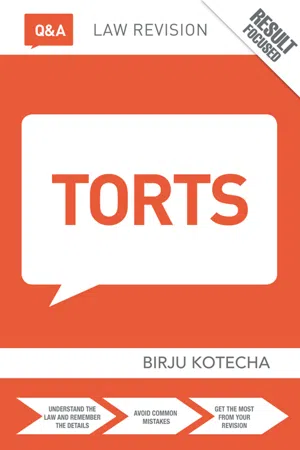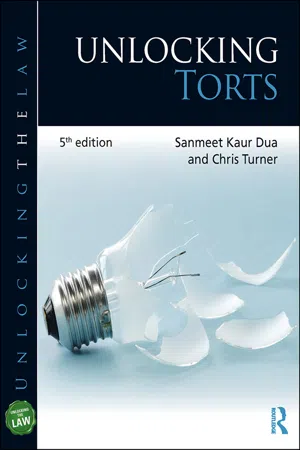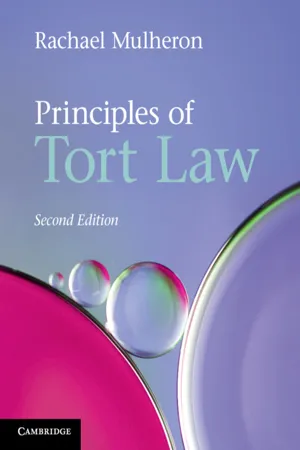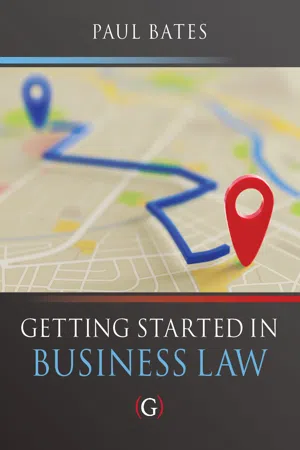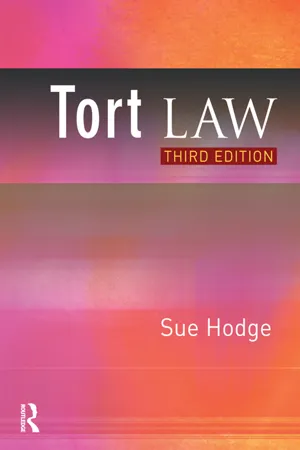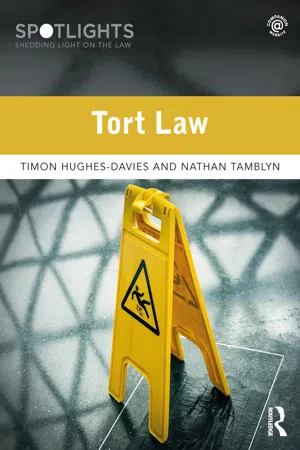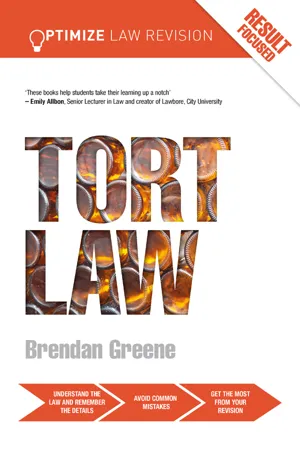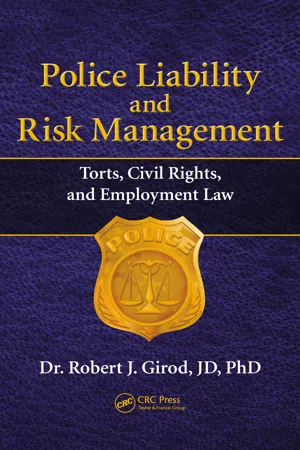Law
Occupiers Liability
Occupiers liability refers to the legal responsibility of a person who occupies or controls a property to ensure the safety of visitors and trespassers. This duty of care includes maintaining the premises in a safe condition, warning of any hazards, and taking reasonable steps to prevent accidents or injuries. The laws governing occupiers liability aim to protect individuals from harm while on someone else's property.
Written by Perlego with AI-assistance
Related key terms
1 of 5
10 Key excerpts on "Occupiers Liability"
- eBook - ePub
- Birju Kotecha(Author)
- 2014(Publication Date)
- Taylor & Francis(Publisher)
7 Occupiers’ Liability INTRODUCTIONOccupiers’ liability is a specialised branch of the tort of negligence and is tested in most examinations year after year. The area is governed by statute – namely, theChecklistOccupiers’ Liability Act 1957and theOccupiers’ Liability Act 1984. Thus, in addition to the common law concepts of duty, breach, causation and remoteness, attention must be paid to the statutes and the particular sections that elaborate on the common law principles. Be aware that in moving around a premises, a person may well change in status from a visitor to a non-visitor – and therefore being at first subject to the1957 Actto being subject to the1984 Act. By doing so, it will be much more difficult for that person to demonstrate that they are owed a duty of care, and this difference should be brought out in answers. This chapter has three problem questions and one essay question. Many students find occupiers’ liability challenging insofar as questions can involve many issues, so it is important to be wise with timing, focus on the critical issues and have a sound grasp of the statutes to assist with your structure.(a) the definitions of occupiers, visitors and non-visitors; (b) the duty regarding children and skilled persons, independent contractors as well as the legal effect of warnings; (c) the exclusion of duty; (d) the circumstances under which a duty to a non-visitor arises and the nature of this duty as distinct from a duty to visitors.Students must be familiar with the following areas:Aim HigherStrong candidates show a grasp of all the relevant features that comprise occupiers’ liability including ‘premises’ and ‘occupier’ but without dwelling on these where they are not relevant. You must concisely apply the relevant provisions of the statute. Also, most tort students will have a statute book that is accessible to them in the exam, so it will serve little purpose to copy out entire and lengthy sections as this will not receive much credit and it will also waste time. Better candidates will paraphrase the key section or even better to simply refer to sections and apply them on the facts without over describing the section. In addition Tomlinson v Congleton - eBook - ePub
- Wendy Laws(Author)
- 2021(Publication Date)
- Taylor & Francis(Publisher)
PART 8Occupiers’ liabilityPassage contains an image
13Occupiers’ liability: visitors
DOI: 10.4324/9781003133698-22
This and the following chapter cover the liability a person may incur where someone comes on to their premises and is injured by the dangerous state of the premises. Occupiers’ liability to persons who enter the premises as lawful visitors is covered here. Liability to persons entering as trespassers is covered in the next chapter.13.1 Chapter overviewIn order to put occupiers’ liability in context, this chapter begins with an overview of some issues which are relevant to both visitors and trespassers. In particular, it notes that the occupier’s duties are governed by statute.Then, turning to the liability of an occupier to their visitors, it first identifies the parties to a claim: who is an occupier and who is a visitor? It then explains the nature and content of the occupier’s statutory duty of care to their visitors. It outlines how that duty may be discharged so that the occupier is not in breach. It notes that the usual principles for causation of damage apply. Finally, it considers defences.
Look at this problem scenario:13.2 Introduction to occupiers’ liabilityA man owns a house with a large garden. He invites some friends to a garden party. Unfortunately, one of the guests trips over a defective paving slab and breaks her ankle.Suppose that a neighbour of the householder is not an invited guest at the garden party but nevertheless sneaks into the garden uninvited. She cuts her hand on some barbed wire.- Would the householder be liable to the friend for her injury?
- Would it be different if the paving slab had been recently laid by a building contractor engaged by the householder?
- eBook - ePub
- Sanmeet Kaur Dua, Chris Turner(Authors)
- 2019(Publication Date)
- Routledge(Publisher)
Chapter 10 ), or there may in any case be an action in negligence available.Liability for land and premises falls into two distinct areas:Occupiers’ liability is a fairly recent tort and is found in two statutes:■ Liability by an occupier of premises for loss or injury caused by the state of the premises – such liability can also be divided according to whom has suffered the loss or injury.■ Liability by a person other than an occupier of land for defects in the premises themselves – this involves landlords and builders.■ the Occupiers’ Liability Act 1957 – which is concerned with the duty of care owed to all lawful visitors; and■ the Occupiers’ Liability Act 1984 – which is concerned with the duty owed to people other than lawful visitors, the major group here being trespassers.Both areas then are statutory in form, but certainly in the case of occupiers’ liability have developed out of negligence. As a result much of the terminology and many of the principles are the same or similar to basic negligence principles. Indeed, though the Acts do contain extensive definition, where definitions are not supplied in the Acts these are to be found in the common law.trespasser A person who enters premises without permission or who exceeds the permission they are givenInevitably there is some overlap with negligence. The basic liability arises from the loss or injury caused by the ‘state of the premises’. Loss or damage that arises other than because of the state of the premises then should be claimed for under negligence where this is possible. - eBook - PDF
- Rachael Mulheron(Author)
- 2020(Publication Date)
- Cambridge University Press(Publisher)
PART II Specific Negligence Regimes 581 12 Occupiers’ Liability THE CAUSE OF ACTION DEFINED This chapter concerns the liability of occupiers of premises, D, towards either lawful visitors or trespassers, C, who are injured (or killed) while on those premises. §12.1 The law of occupiers’ liability is governed, in English law, by two statutes: • The Occupiers’ Liability Act 1957 (‘the OLA 1957’) governs the liability of an occupier of premises to his lawful visitors. An occupier owes any lawful visitor a ‘common duty of care’, the terms of which are ‘a duty to take such care as in all the circumstances of the case is reasonable to see that the visitor will be reasonably safe in using the premises for the purposes for which he is invited or permitted by the occupier to be there’ (per s 2(2)); or • The Occupiers’ Liability Act 1984 (‘the OLA 1984’) governs the liability of an occupier to tres-passers (or unlawful visitors). An occupier does not owe a ‘common duty of care’ to a trespasser; rather, the occupier’s duty of care is far more limited. The law of occupiers’ liability is a true mix of statutorily stated principles and common law negligence. Both Acts impact, to some degree, on whether the occupier owed a duty of care or breached that duty and the defences available to him, while causation and remoteness are entirely governed by the common law. Where the Acts apply, it has been judicially clarified that their provisions were truly intended to replace the common law rather than merely to consolidate it (per Maloney v Torfaen CBC 1 ). As Carnwath LJ explained in Maguire v Sefton MBC , 2 the law of occupiers’ liability ‘had become over-complicated by subtle distinctions derived from the case law over several decades’, and the reform proposals ‘were not pure codification in the strict sense. They were … codification-plus; that is, sorting out the law by a combination of re-statement, and amendment, as necessary’. - eBook - PDF
- Paul Bates(Author)
- 2021(Publication Date)
- Goodfellow Publishers(Publisher)
One thing that we can be fairly sure about, is that Mr P and Mrs C are not so friendly as they used to be… An occupier’s liability for premises You will be pleased to hear that in relation to all the above, the concept of occupier’s liability is relatively easy. Occupier’s liability stems from the wider tort of negligence but it has a narrower focus as it deals with the duty of care which an ‘occupier’ of ‘premises’ may have to visitors to these premises. There are only two Acts of Parliament which operate in this area. These are: The Occupier’s Liability Act 1957, and The Occupier’s Liability Act 1984. The earlier act deals with ‘lawful’ visitors to premises and the later act deals with ‘non lawful’ visitors (mainly trespassers). The 1957 Act defines premises as, “any fixed or moveable structure, including any vessel, vehicle or aircraft.” As the Act mentions not just fixed objects but also moveable ones, we now know from case law following the Act, that the definition of premises can also extend to any buildings, including outbuildings, lifts, chairs, ladders and even scaffolding. I was asked recently whether a submarine might be included here. I suspect the answer is yes, as a submarine is a vessel. Unfortunately, neither Act gives us a full definition of who an ‘occupier’ actually is, so once more we’ve had to rely on decided case law to give us some satisfactory definitions. Luckily the two areas above, (occupier and premises) are the only tricky issues you are likely to find with occupier’s liability. We’ll deal with these 121 5 The law of tort shortly. Let’s start with the duty of care the earlier Act tells us we have to visitors to the places where we live, and to any business premises we might be using. - 4 Negligence and dangerous premises The Occupiers’ Liability Acts 1957 and 1984Although the problems posed by dangerous premises are addressed in this chapter, it is important to bear in mind that many of the matters already discussed will be relevant to this. We will come back to this point later.The essence of the problem connected with dangerous premises is to identify those persons to whom a duty of care is owed, the person who owes that duty and the extent of the duty. This chapter starts by considering the distinction between lawful and unlawful visitors and discussing the identity of the person who owes the duty. It will go on to discuss the nature of the duty owed to particular categories of visitors.Lawful and unlawful visitorsUntil recently the occupier of land and premises could escape liability for negligent injury caused to someone on that land or in those premises by establishing that the person had no right to be there. This is an example of the maxim discussed under the heading ‘Participation in an unlawful act (ex turpi causa non oritur actio)’ in Chapter 5 (see pp. 106 –107 ). A person classified as a trespasser was historically given no protection.Problems could arise in respect of lawful visitors as the duty of care owed by an occupier varied according to the nature of the permission which allowed the person to enter the land. Parliament acted, following the recommendations of the Third Report of the Law Reform Committee (Cmd 9305) 1954, which dealt with some of these problems, and then passed the Occupiers’ Liability Act 1957.The Act ensures that any visitor with either express or implied permission or lawful authority to be on the land has the benefit of the protection of the Act. It is not difficult to identify such categories of visitors. Persons who have received a specific invitation are obviously included as are those who have paid for the right of entry, for example to a theme park or to a cinema. Others included are those who visit premises as a result of implied permission, for example a person delivering milk which has been ordered or a person delivering the post, or the fire brigade summoned to deal with a fire emergency. Lawful authority will extend to the police and other persons exercising rights granted by a warrant.
- eBook - ePub
- Timon Hughes-Davies, Nathan Tamblyn(Authors)
- 2019(Publication Date)
- Routledge(Publisher)
Chapter 11Occupiers’ Liability
This chapter discusses the duty of occupiers to take reasonable care of visitors under the Occupiers’ Liability Act 1957, and of non-visitors under the Occupiers’ Liability Act 1984.If someone trips over a loose tile on the floor of a hotel lobby, can they sue for their injury? What if that person was trespassing? This chapter is about the duty of care owed by occupiers of ‘premises’ (typically land or buildings) to other people on those premises. The duty of care owed to visitors is governed by the Occupiers’ Liability Act 1957. The duty of care owed to non-visitors (usually trespassers) is governed by the Occupiers’ Liability Act 1984.This chapter proceeds as follows. First, we shall consider some themes and concepts common to both Acts. Second, we shall discuss the duty of care owed to visitors. Third, we discuss the duty of care owed to non-visitors. Finally, we shall explore some common defences.____________As you read
- Identify the differences between the regimes of the 1957 Act and the 1984 Act.
- Identify the common ground shared by the two Acts.
- Be aware of how the facts might give rise to other causes of action in tort besides occupiers’ liability.
- Consider whether the law strikes a fair balance between the duties imposed on an occupier and the person injured on their premises.
11.1 Common themes
In this section, we explore how occupiers’ liability is concerned with the condition of the premises, rather than activities performed on those premises. Then we turn to consider concepts (like ‘occupier’ and ‘premises’) common to both the 1957 Act and the 1984 Act.Liability for condition of premises
Although there remains some academic discussion of the point, the case law seems to suggest that occupiers’ liability is concerned only with the condition of the premises, that is, whether the premises themselves are safe or not. It is not concerned with the occupier’s activities on the premises.1 - eBook - ePub
- Brendan Greene(Author)
- 2017(Publication Date)
- Routledge(Publisher)
1984 , were passed to clarify the law and to set out detailed rules. These rules are in effect statutory negligence.At common law the entrants to land were divided into four categories which were created inAddie & Sons v Dumbreck [1929]AC 358 as set out in the table below. The duty owed became progressively less until it came to trespassers when the duty was merely not to harm them. Although the categories are still relevant the duties owed have been changed by the Occupiers’ Liability Acts .Contractual visitor Occupier has a material interest in their visit. Duty to see that the premises are safe, e.g. a paying customer at a swimming pool Invitee Duty to prevent damage from an unusual danger, e.g. a customer in a shop is owed this duty Licensee Duty to protect from any concealed danger the occupier knows of, e.g. asking a friend to your house Trespasser Duty not to intentionally or recklessly harm, e.g. someone climbs over your garden wall The common law rules are still relevant as s1 Occupiers’ Liability Act 1957 (OLA 1957 ) provides that visitors are those who were invitees or licensees at common law. The OLA 1957 also includes contractual visitors under s5(1). All these three categories are now ‘visitors’ and owed the common duty of care under s2(1) OLA 1957 . Trespassers are now covered by the OLA 1984 .If an entrant to land falls outside the rules of both Occupiers’ Liability Acts then the common law rules apply to them. InBritish Railways Board v Herrington - eBook - PDF
- Douglas Wood, Paul Chynoweth, Julie Adshead, Jim Mason(Authors)
- 2021(Publication Date)
- Wiley-Blackwell(Publisher)
The warning must come from the occupier and it must be adequate in that it speci fi es the danger clearly so that the visitor can avoid it. The occupier ’ s duty is to render the visitor safe rather than the premises. In Rae v Mars (UK) 137 , where a surveyor was injured when inspecting a storehouse in a factory, it was sug-gested that if unusual dangers exist there should be additional warnings indicating the immediacy of the danger together with the possibility of additional safeguards such as barriers if they are appropriate. There is no duty on an occupier to warn of obvious dangers 138 but if the danger is not obvious the warning must be detailed enough for the occupier to put the visitor on guard for their own safety. The following defences may have application to lawful visitors. (a) Volenti Where a visitor voluntarily accepts the risk and choses to enter the premises the defence of consent may be applicable. (b) Contributory negligence Visitors who fail to use reasonable care for their own safety may fi nd their damages reduced when an apportionment takes place between the occupier and the visitor. (c) Exclusion An occupier may attempt to exclude liability by a notice communicated to a visitor or by a contractual term. Any limitation of liability by the occupier must be read subject to the Unfair Contract Terms Act 1977 in situations where there is ‘ business liability. ’ This includes professions and activities undertaken by central and local government. Any attempt to exclude liability for death or personal injury caused by negligence will not be upheld. In the case of property damage the stipulation will not be upheld unless it is reasonable in the circumstances. If lawful visitors have little option other than to enter the premises the occupier will fi nd it dif fi cult to exclude liability. (D) Trespassers Trespassers are not governed by the Occupiers Liability Act 1957. Historically, an occupier of premises owed no duty of care to trespassers. - No longer available |Learn more
Police Liability and Risk Management
Torts, Civil Rights, and Employment Law
- Robert J Girod(Author)
- 2013(Publication Date)
- Routledge(Publisher)
39 © 2010 Taylor & Francis Group, LLC Duty of Care Owners and Occupiers of Land: Duty to Take Precautions for Unreasonably Dangerous Conditions Liability Outside of the Premises The duty to protect others “outside the premises” from dangers originating on the property of owners and occupiers of land is another major issue in tort liability. For example, in one case a plaintiff injured herself when she crashed into a tree, which had fallen onto a highway from the defendant’s property. The court held that it is generally a question of fact as to whether a landowner has taken reasonable care in protecting people outside his land from danger-ous conditions existing upon the land ( Taylor v. Olsen , Or. Sup. Ct., 282 Or. 343, 578 P.2d 779 (1978)). The general rule is that a landowner has no duty to protect persons outside of his property from natural conditions existing on the property. But, liability has been found where the landowner was aware of the structural defects (such as a tree) and failed to take reasonable precau-tions to prevent harm ( Turner v. Ridley , 144 A.2d 269 (D.C. 1958)). Another case held that landowners whose property is adjacent to public sidewalks or highways (such as a ballpark) owe a duty of care to take reasonable precau-tions for the protection of the traveling public. What precautions are reason-able must depend upon the facts and circumstances of the particular case ( Salevan v. Wilmington Park, Inc . , Del. Sup. Ct., 72 A.2d 239 (1950)). Liability on the Premises: Invitees, Licensees, and Trespassers The duty owed to someone entering onto one’s property (premises) depends upon the status of the person entering the property. In property law, such persons are known as either (a) invitees, (b) licensees, or (c) trespassers. This relationship determines the duty owed and the level of what is known in tort law as premise liability.
Index pages curate the most relevant extracts from our library of academic textbooks. They’ve been created using an in-house natural language model (NLM), each adding context and meaning to key research topics.
